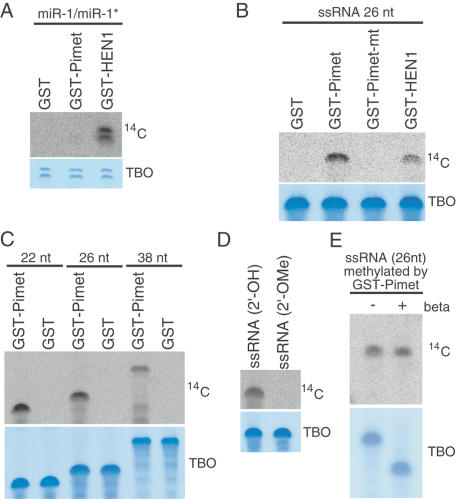Figure 4.
GST-Pimet methylates single-stranded small RNAs in vitro. (A) miR-1/miR-1* duplexes (0.04 nmol/50 μL) were incubated with GST, GST-Pimet, and GST-HEN1 in the presence of 14C-labeled SAM. Resultant small RNAs were run on a denaturing acrylamide gel. The top panel (14C; autoradiograph of 14C-labeled RNAs) shows that only GST-HEN1 is able to transfer methyl groups from SAM to miRNA/miRNA* duplexes. The bottom panel shows a staining image (TBO, Toluidine Blue O) of the top gel, which indicates that the same amounts of miRNA/miRNA* duplexes were used in all the lanes. (B, top panel) When single-stranded small RNAs (26 nt) are the substrate for the methylation assay (0.5 nmol/50 μL), GST-Pimet shows stronger activity compared with that of GST-HEN1. The bottom panel shows a staining image of the top gel. (C) ssRNAs (22 nt, 26 nt, and 38 nt) were methylated by GST-Pimet in vitro. GST-Pimet seems to be indifferent to the length of substrates, unlike Arabidopsis HEN1 that hardly recognize 25-nt or longer RNAs as substrates in an in vitro methylation assay (Yang et al. 2006). (D) 2′-O-methyl modification of 26-nt ssRNAs prevents methylation, suggesting that only the 2′-hydroxyl group on the ribose of the far 3′ nucleotide is methylated by Pimet. (E) ssRNAs (26 nt) were methylated by GST-Pimet as in B and subjected to oxidation and β-elimination treatment. Only methylated ssRNAs (not visible in the bottom “TBO” panel) showed resistance (14C) to the chemical treatment.

